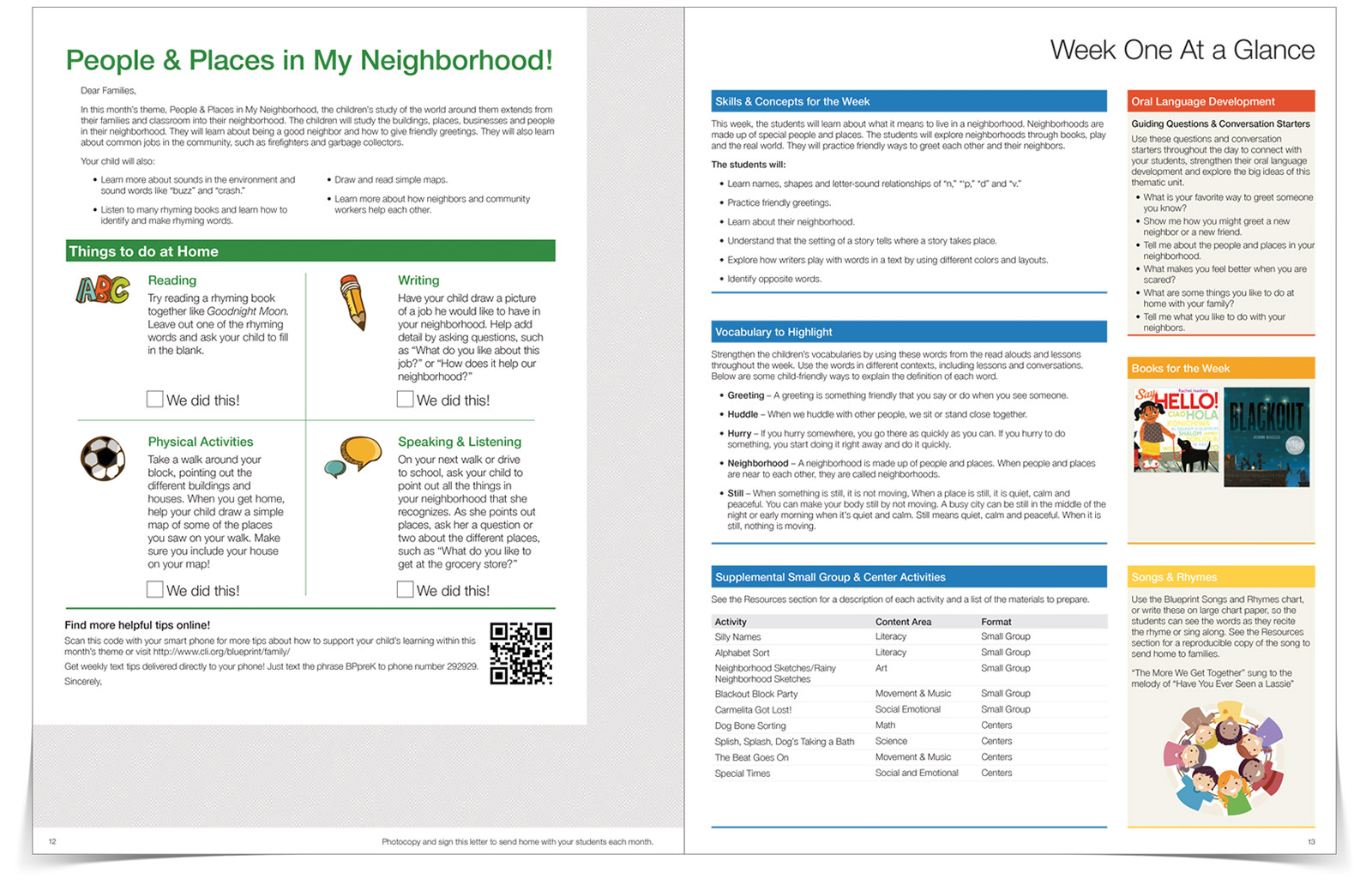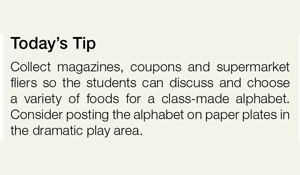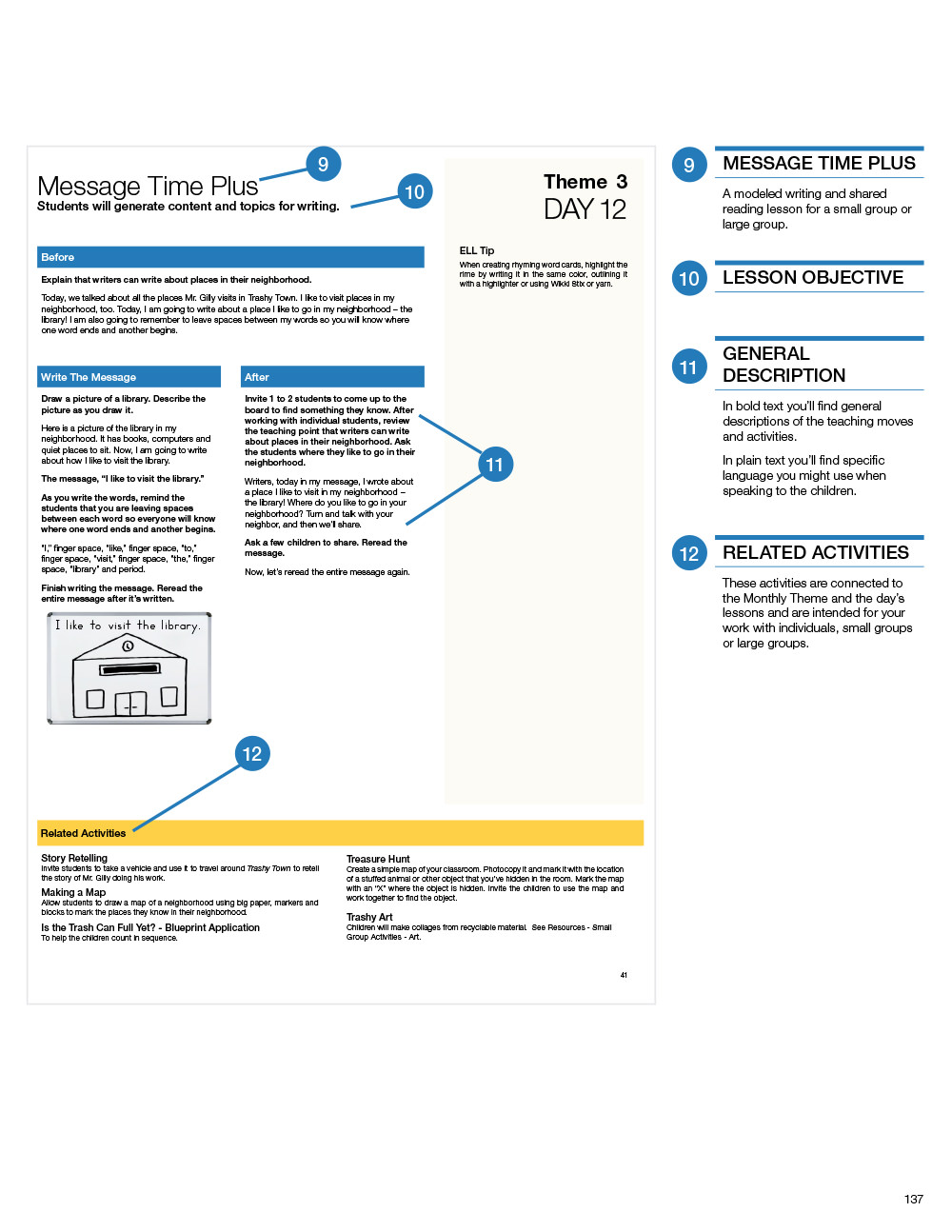Each theme guide is comprehensive – it’s the only resource teachers will need for each month's unit.
 In each theme guide, teachers will find:
In each theme guide, teachers will find:
- List of skills and concepts
- Overview of the unit
- Monthly ongoing learning project
- A description of each of the 8 picture books
- A description of how the dramatic play center can be organized to match the monthly thematic concept, with directions for how to launch and maintain it.
- A featured strategy to enhance teachers’ interactions with children while they play - these suggestions help teachers engage children in play, foster oral language development and foster connections between children and the adults in their lives. Specific scenarios are described and tips for specific teacher language are offered.
- A reproducible family letter to send home each month.
- Week at a Glance. Providing teachers with an overview of the skills and concepts that they will focus on, vocabulary to highlight and child-friendly definitions, guiding questions and conversation starters that match the thematic content for the week, the books and song for the week and suggested centers and small group work, full descriptions of which can be found in the back of the theme guide.
Family Letter & Week at a Glance
A reproducible family letter is included which offers families an overview of the theme, learning goals and suggested activities in four domains (reading, writing, physical activities and speaking and listening).
Each week we offer teachers a week at a glance which provides them with an overview of the skills and concepts that they will focus on, vocabulary to highlight and child-friendly definitions, guiding questions and conversation starters that match the thematic content for the week, the books and song for the week and suggested centers and small group work, full descriptions of which can be found in the back of the theme guide.

Intentional Read Aloud
 Each theme guide offers daily Intentional Read Alouds which provide a road-map for teachers to guide children in developing skills in a wide array of areas. Children are encouraged to think, talk and respond during each lesson with plenty of opportunities for singing, moving, talking, and sharing. Each lesson should last approximately 10 minutes – it was important to us that we keep in mind the preschooler’s ability to pay attention.
Each theme guide offers daily Intentional Read Alouds which provide a road-map for teachers to guide children in developing skills in a wide array of areas. Children are encouraged to think, talk and respond during each lesson with plenty of opportunities for singing, moving, talking, and sharing. Each lesson should last approximately 10 minutes – it was important to us that we keep in mind the preschooler’s ability to pay attention.
The daily Intentional Read Aloud serves as a springboard for children to develop their communication skills. Our intentional read alouds are unique because they focus on specific, discrete objectives. Each lesson has a specific objective, taken from the 10 Literacy Strands that make up the Scope and Sequence.
Our intentional read alouds are also unique because they encourage teachers to model their thinking. As the most experienced readers in the classroom; we encourage teachers to model the thinking that mature readers do. To talk out loud about how they make sense of a book, what questions they ask, how they figure out the meaning of a word, what connections they are making to the text.

In Blueprint lesson plans, you will see specific questions and engagement opportunities that you can offer to your children. Some of these include talking about the book – we teach children how to lean in and talk with a partner, how to turn and talk, how to share their thinking with the group, how to use sentence stems such as “I wonder” and “I learned” to expand their oral language and comprehension skills.
Social skills children need to learn are both embedded in these lessons and taught explicitly. Skills such as learning how to listen, taking turns, accept of multi-cultural differences, how to speak in a group, and, learning compassion and empathy.
We also encourage the rereading of books. When a child hears a book read several times it helps them understand and notice new things.
Message Time Plus ®
 Side by side with the intentional read aloud is Message Time Plus. This is a unique instructional practice that incorporates both modeled writing and shared reading in order to provide children with an authentic literacy experience.
Side by side with the intentional read aloud is Message Time Plus. This is a unique instructional practice that incorporates both modeled writing and shared reading in order to provide children with an authentic literacy experience.
Modeled writing is a process in which the teacher brainstorms, plans, composes, and transcribes a piece of written text as children watch and respond. The teacher is “thinking aloud” while writing. For the English Language Learner, this modeled process is crucial! It provides an opportunity for children to learn often difficult semantic & grammatical structures in English all while considering the craft of writing.
Shared reading is a process in which the teacher and children join together to read a piece of written text. Children learn how to predict words in context. They increase and develop new vocabulary. Recognize letters and sounds in context. Understand concepts of the printed word.
When you combine these two practices into one – as we have done with MTP - the benefits are incredible and truly support children’s pre-reading skills. In just a few minutes of instruction, Message Time Plus provides children with practice and exposure to numerous literacy skills.
MTP is preplanned but NOT prewritten – the teacher is writing in front of the children to guide them to use their emerging reading skills in context and to give immediate feedback. The purpose of MTP is to create an authentic reading & writing experience, not simply to say hello to the children in the morning.

The message evolves over time. We begin with a picture to let the readers and writers know that pictures convey meaning. Eventually the message grows as children’s comfort with print grows, to include labels and then simple and more complex sentences. Each day we show what the message could look like.
Other Resources Found in the Theme Guide

Classroom Culture Tips
Blueprint provides teachers with a daily idea for promoting a strong classroom culture based on kindness and cooperation. Children will grow their skills in learning how to manage their emotions, collaborate, and communicate.

Family Tips
Twice each week, the curriculum offers a suggestion for how teachers can bridge the home school gap by sharing ways to help families engage with the skills and content their children are learning.

Today’s Tip
This is a daily literacy tip, specifically tied to either the IRA or MTP lesson.

ELL Tip
Once each week, we offer suggestion for ways teachers can support English language learners in their classrooms. This tip is supplemented with weekly online suggestions for ways to adapt the skills and content for English language learners to make it more accessible.

Songs, Rhymes & Chants
Each week we feature a song or rhyme related to the theme. We ask teachers to lead their children in singing or chanting each and every day using interactive methods such as choral reading, shared reading and echo reading. We practice fluency through using “sunny” voices and “robot” voices. We also include suggestions for movement such as dancing and hopping. Copies of each of the songs can be found in the back of the theme guide for teachers to photocopy and send home to the families.

Assessment Tips
Each week we offer a tip on how to incorporate formal and informal assessments to guide instruction and meet children’s individual needs.

Related Activities
This section guides teachers in selecting activities that relate to the content of the lessons that children can do in small groups or individually. Full descriptions of these can be found in the back of the theme guide.

Additional Information
At the back of each theme guide, teachers will find supplemental resources related to literacy. These reference pages are designed to enhance their understanding of different aspects of pre-k reading and writing skills and practices such as taking dictation, the use of word walls and reading environmental print.
The theme guide ends with a list of supplemental books related to the theme. Several of these titles will be found in the supplemental read aloud collection that comes with the curriculum.










